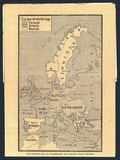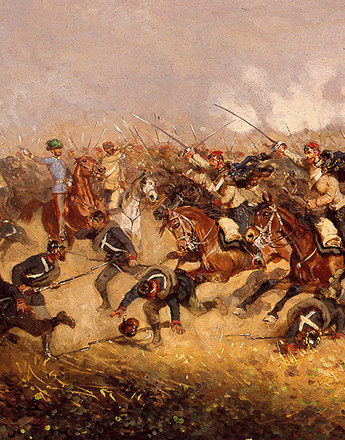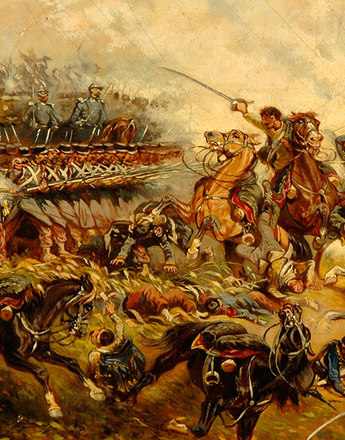In connection with the Ottoman Empire’s inexorable nineteenth-century decline, Tsar Nicholas II coined the expression of the ‘sick man on the Bosphorus’. Another empire in crisis was Austria-Hungary.
Major landmarks in the decline of the Habsburg dominions had been the loss of Lombardy in 1859, the loss of Venetia in 1866, and defeat at the hands of the Prussian at Königgrätz in the same year. Under Franz Joseph the Monarchy had definitely forfeited the hegemony in the German-speaking world and Italy upon which its identity as a great power had traditionally rested. The unifications of Italy (1860/61) and of Germany (1871) had reduced the Habsburg Monarchy to a second-class great power.
Nevertheless, the very size and particular geopolitical function of the Habsburg Monarchy made it a more or less stable matrix for the colourful mish-mash of central and south-eastern European peoples. As such it was seen by the other powers as being of critical importance for the European balance of power.
However, the very fact that the Dual Monarchy had so many peoples gave it a complicated position in the concert of the powers, for the demands of the various ethnic groups in an age of rampant nationalism were never just an internal problem: they also had a huge effect on foreign policy. The Czech, south Slav, or Polish questions hampered the Dual Monarchy in its scope of action. The foundations of the Monarchy’s territorial integrity were most especially shaken by irredentism amongst its Italian, Serb, Rumanian and Ruthenian subjects, whose ‘mother countries’, claiming to be their protecting powers, made demands oriented towards these Austrian subjects joining their co-nationals outside the Monarchy. Even the Habsburgs’ German-speakers, whose privileged position as the ‘people of state’ was increasingly questioned, were torn between Austrian patriotism and German nationalism in their search for their real identity.
A particularly dangerous example of the problem of the nationalities mixing up home and foreign politics was the Balkan policy pursued by Austria as it sought make its mark as an expanding great power. While the occupation of Bosnia-Herzogovina in 1878 was apparently a territorial gain, it resulted in Austrian foreign policy becoming ever more narrowly focused on the Balkans. Austria-Hungary’s deliberately aggressive stance led to a conflict of interests with Russia and intensified the necessity of an alliance with Germany.
This ‘Dual Alliance’ was concluded in 1879. Although Austria was definitely the junior partner, its subsequent political closeness to Germany had an enduring effect on its foreign policy and had a critical influence upon the Monarchy in its last decades.
In 1882 Italy joined the Austro-German Dual Alliance, turning it into the ‘Triple Alliance’. For Austria-Hungary this meant a consolidation of the southern border through the neutralization of its Italian subjects’ irredentism. Nevertheless, the Apennine state was an uncertain ally and more of a rival than a partner with shared interests.
On the home front the Dual Monarchy’s renunciation of aspirations to great power status freed up resources for political, social and economic modernization. From the 1870s onwards it enjoyed two decades of consolidation and a final heyday that lasted until around 1900, when internal conflicts led the Habsburg empire into its final crisis.
Translation: Peter John Nicholson
Bridge, Francis Roy: Österreich(-Ungarn) unter den Großmächten, in: Wandruszka, Adam/Urbanitsch, Peter (Hrsg.): Die Habsburgermonarchie 1848–1918, Band VI: Die Habsburgermonarchie im System der internationalen Beziehungen, Wien 1989, Teilband 1, 196–373
Hanisch, Ernst: Der lange Schatten des Staates. Österreichische Gesellschaftsgeschichte im 20. Jahrhundert [Österreichische Geschichte 1890–1990, hrsg. von Herwig Wolfram], Wien 2005
Rauchensteiner, Manfried: Der Erste Weltkrieg und das Ende der Habsburgermonarchie 1914–1918, Wien u. a. 2013
Rumpler, Helmut: Eine Chance für Mitteleuropa. Bürgerliche Emanzipation und Staatsverfall in der Habsburgermonarchie [Österreichische Geschichte 1804–1914, hrsg. von Herwig Wolfram], Wien 2005
Traum und Wirklichkeit. Wien 1870–1930. Katalog der 93. Sonderausstellung des Historischen Museums der Stadt Wien 1985, Wien 1985
Wandruszka, Adam (Hrsg.): Die Habsburgermonarchie 1848–1918, Band VI: Die Habsburgermonarchie im System der internationalen Beziehungen (2 Bände), Wien 1989 und 1993
Das Zeitalter Kaiser Franz Josephs – 2. Teil: 1880–1916. Glanz und Elend. Katalog der Niederösterreichischen Landesausstellung auf Schloss Grafenegg 1987, Wien 1987








